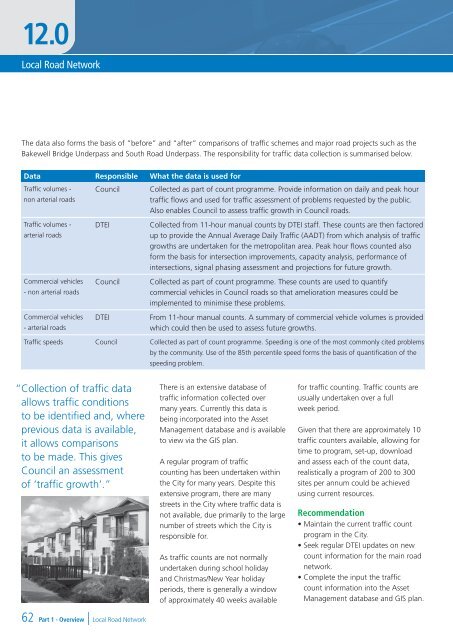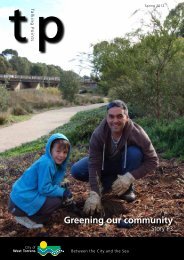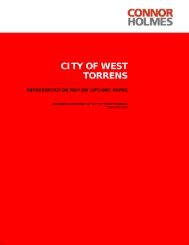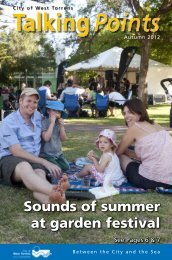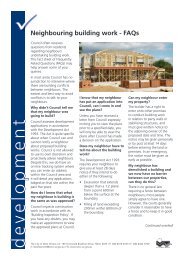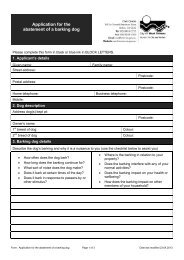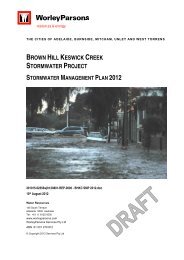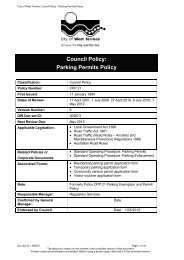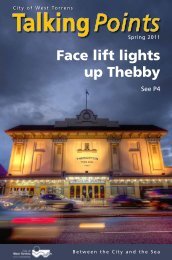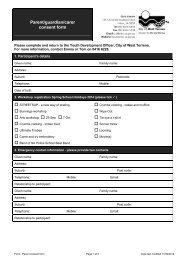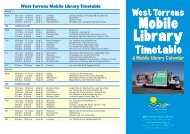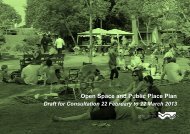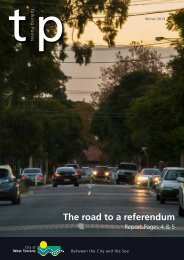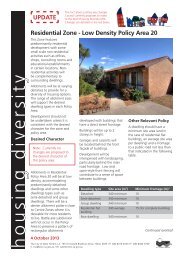Recommendations - City of West Torrens - SA.Gov.au
Recommendations - City of West Torrens - SA.Gov.au
Recommendations - City of West Torrens - SA.Gov.au
Create successful ePaper yourself
Turn your PDF publications into a flip-book with our unique Google optimized e-Paper software.
12.0<br />
Local Road Network<br />
The data also forms the basis <strong>of</strong> “before” and “after” comparisons <strong>of</strong> traffic schemes and major road projects such as the<br />
Bakewell Bridge Underpass and South Road Underpass. The responsibility for traffic data collection is summarised below.<br />
Data Responsible What the data is used for<br />
Traffic volumes -<br />
non arterial roads<br />
Council Collected as part <strong>of</strong> count programme. Provide information on daily and peak hour<br />
traffic flows and used for traffic assessment <strong>of</strong> problems requested by the public.<br />
Also enables Council to assess traffic growth in Council roads.<br />
Traffic volumes -<br />
arterial roads<br />
Commercial vehicles<br />
- non arterial roads<br />
Commercial vehicles<br />
- arterial roads<br />
DTEI<br />
Council<br />
DTEI<br />
Collected from 11-hour manual counts by DTEI staff. These counts are then factored<br />
up to provide the Annual Average Daily Traffic (AADT) from which analysis <strong>of</strong> traffic<br />
growths are undertaken for the metropolitan area. Peak hour flows counted also<br />
form the basis for intersection improvements, capacity analysis, performance <strong>of</strong><br />
intersections, signal phasing assessment and projections for future growth.<br />
Collected as part <strong>of</strong> count programme. These counts are used to quantify<br />
commercial vehicles in Council roads so that amelioration measures could be<br />
implemented to minimise these problems.<br />
From 11-hour manual counts. A summary <strong>of</strong> commercial vehicle volumes is provided<br />
which could then be used to assess future growths.<br />
Traffic speeds Council Collected as part <strong>of</strong> count programme. Speeding is one <strong>of</strong> the most commonly cited problems<br />
by the community. Use <strong>of</strong> the 85th percentile speed forms the basis <strong>of</strong> quantification <strong>of</strong> the<br />
speeding problem.<br />
“ Collection <strong>of</strong> traffic data<br />
allows traffic conditions<br />
to be identified and, where<br />
previous data is available,<br />
it allows comparisons<br />
to be made. This gives<br />
Council an assessment<br />
<strong>of</strong> ‘traffic growth’.”<br />
62<br />
Part 1 - Overview | Local Road Network<br />
There is an extensive database <strong>of</strong><br />
traffic information collected over<br />
many years. Currently this data is<br />
being incorporated into the Asset<br />
Management database and is available<br />
to view via the GIS plan.<br />
A regular program <strong>of</strong> traffic<br />
counting has been undertaken within<br />
the <strong>City</strong> for many years. Despite this<br />
extensive program, there are many<br />
streets in the <strong>City</strong> where traffic data is<br />
not available, due primarily to the large<br />
number <strong>of</strong> streets which the <strong>City</strong> is<br />
responsible for.<br />
As traffic counts are not normally<br />
undertaken during school holiday<br />
and Christmas/New Year holiday<br />
periods, there is generally a window<br />
<strong>of</strong> approximately 40 weeks available<br />
for traffic counting. Traffic counts are<br />
usually undertaken over a full<br />
week period.<br />
Given that there are approximately 10<br />
traffic counters available, allowing for<br />
time to program, set-up, download<br />
and assess each <strong>of</strong> the count data,<br />
realistically a program <strong>of</strong> 200 to 300<br />
sites per annum could be achieved<br />
using current resources.<br />
Recommendation<br />
• Maintain the current traffic count<br />
program in the <strong>City</strong>.<br />
• Seek regular DTEI updates on new<br />
count information for the main road<br />
network.<br />
• Complete the input the traffic<br />
count information into the Asset<br />
Management database and GIS plan.


